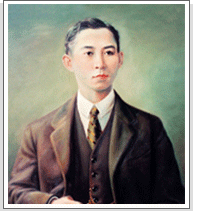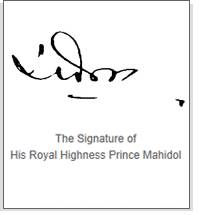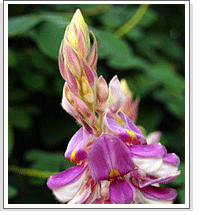| Our History |
 Mahidol University has its origins in the
establishment of
Siriraj Hospital
in 1888 by His Majesty King
Chulalongkorn (Rama V), and the hospital's medical
school is the oldest institution of higher learning
in Thailand, granting its first medical degree in
1893. Later becoming the University of Medical
Sciences in 1943, Mahidol University was renamed
with great honor in 1969 by
H.M. King Bhumibol Adulyadej
, after his Royal Father,
H.R.H Prince Mahidol of Songkla
, who is widely known as the
"Father of Modern Medicine and Public Health in Thailand". Mahidol University has its origins in the
establishment of
Siriraj Hospital
in 1888 by His Majesty King
Chulalongkorn (Rama V), and the hospital's medical
school is the oldest institution of higher learning
in Thailand, granting its first medical degree in
1893. Later becoming the University of Medical
Sciences in 1943, Mahidol University was renamed
with great honor in 1969 by
H.M. King Bhumibol Adulyadej
, after his Royal Father,
H.R.H Prince Mahidol of Songkla
, who is widely known as the
"Father of Modern Medicine and Public Health in Thailand".
Mahidol University has since developed into one
of the most prestigious universities in Thailand,
internationally known and recognized for the
high caliber of research and teaching by its
faculty, and its outstanding achievements in
teaching, research, international academic
collaboration and professional services. This
diversified institution now offers top quality
programs in numerous social and cultural
disciplines, including the most doctoral
programs of any institution in Thailand, yet has
maintained its traditional excellence in
medicine and the sciences.
|
|
| The Motto & Philosophy |
The overall
philosophy of Mahidol University is best captured by
the
university motto: Attānaṁ
upamaṁ kare "อตฺตานํ อุปมํ กเร"  In the Pali language, this translates as the
Golden Rule in English:
'Do unto others as you would have others do unto
you'. This underlying theme
pervades every aspect of Mahidol University as
it endeavors to imbue graduates with the
conviction that, aside from achieving academic
excellence, they have a solemn duty to improve
the quality of life for all humanity.
In the Pali language, this translates as the
Golden Rule in English:
'Do unto others as you would have others do unto
you'. This underlying theme
pervades every aspect of Mahidol University as
it endeavors to imbue graduates with the
conviction that, aside from achieving academic
excellence, they have a solemn duty to improve
the quality of life for all humanity.

The university's namesake, H.R.H. Prince Mahidol, has
eloquently stated Mahidol University's universal
view of higher education: 'True success
is not in the learning, but in its application
to the benefit of mankind'. With the
Royal Philosophy as a guiding light, Mahidol
University continues to take progressive action
to internationalize and diversify itself, so
that its graduates will be globally informed as
well as socially aware. In this globalized and
interconnected world, Mahidol University
recognizes that achieving academic and moral
excellence requires maintaining strong
relationships with the world community, and
offering lifelong and equitable quality
education for all.
|
|
| Determination Statement: "Wisdom of the Land" |
 To appreciate the meaning of Mahidol University's new determination statement, "Wisdom of the Land" it is first necessary to take into consideration two key words involved: mahidol, the university's name, and paññā, or the Buddhist conception of wisdom. To appreciate the meaning of Mahidol University's new determination statement, "Wisdom of the Land" it is first necessary to take into consideration two key words involved: mahidol, the university's name, and paññā, or the Buddhist conception of wisdom.
The meaning of mahidol
The word mahidol is derived from the Pali, and also Sanskrit, mahī "land" + tala "ground, level." Mahītala can thus be translated as "the ground of the earth." Other words in Thai with the same morphological structure and meaning are phasuthadol, phuwadol and methanidol (derived respectively from vasudhā + tala, bhuva + tala and medanī + tala. This whole set of words, which can be found in the 1999 edition of the Royal Institute's Thai Dictionary, can all be translated as "the ground of the earth; the surface of the earth." ... More detail
|
|
| Vision |
| Mahidol University is determined to be a world class university. |
|
| Mission |
|
M |
: |
Mastery |
| |
A |
: |
Altruism |
| |
H |
: |
Harmony |
| |
I |
: |
Integrity |
| |
D |
: |
Determination |
| |
O |
: |
Originality |
| |
L |
: |
Leadership |
|
|
| Strategies Objectives |
|
1 |
Research Excellence |
| |
2 |
Teaching and Learing Excellence |
| |
3 |
Health Care and Services Excellence |
| |
4 |
Internationalization |
|
|
| Administrative Strategies |
| |
Harmony in Diversity |
| |
ICT-Based University & Resource Optimization |
| |
Human Capital |
|
|
| The Symbolic Plant |
 Kan phai Mahidol (Afgekia mahidoliae B. L. Burtt & Chermsir.), the symbolic plants of Mahidol University, was named to commemorate the late Princess Mother, Somdej Phra Sri Nakarindra Boromarajajonnani (then Princess Srisangwan Mahidol). It is a rare tropical plant found in limestone mountains in the western side of Thailand. One among only three known species in the genus, A. mahidoliae is a climber in the pea family (Fabaceae). The plant possesses purplish and whitish pea-like florets in inflorescences which are usually in blooms during August to November... More detail Kan phai Mahidol (Afgekia mahidoliae B. L. Burtt & Chermsir.), the symbolic plants of Mahidol University, was named to commemorate the late Princess Mother, Somdej Phra Sri Nakarindra Boromarajajonnani (then Princess Srisangwan Mahidol). It is a rare tropical plant found in limestone mountains in the western side of Thailand. One among only three known species in the genus, A. mahidoliae is a climber in the pea family (Fabaceae). The plant possesses purplish and whitish pea-like florets in inflorescences which are usually in blooms during August to November... More detail |
|
| Continually Expanding in the New Millennium |
On 16 October 2007, the Thailand National legislative Assembly approved Mahidol University as an autonomous institution. This transformation will enhance the university's efficiency, flexibility, and ability to innovate, and standardize its practices with those of other world-class universities.
Recognizing the challenges facing humanity in the new millennium and the fundamental responsibility of higher education institutions to assist in meeting those challenges, Mahidol University follows a policy of constant expansion in the breadth and depth of its facilities and academic endeavors. By remaining globally aware and staying abreast of new academic discoveries and technologies worldwide, Mahidol University continues not only to meet the needs of Thailand for education, training and research, but through internationalization, the needs of the global community as well.
|
|
| Contact and Visitor Information |
To arrange a visit to one of Mahidol University's campuses or obtain further information about the university, please contact: |
International Relations Division
Office of the President Mahidol University
999 Phuttamonthon 4 Road
Salaya, Phuttamonthon Nakhon Pathom 73170, Thailand
Tel: (66) (0) 2849-6230 (Director) (66) (0) 2849-6231-3, (0) 2849-6235-6
Fax: (66) (0) 2849-6237
E-mail: opinter@mahidol.ac.th
Web site: http://www.op.mahidol.ac.th/orir/index.htm |
|
|
|